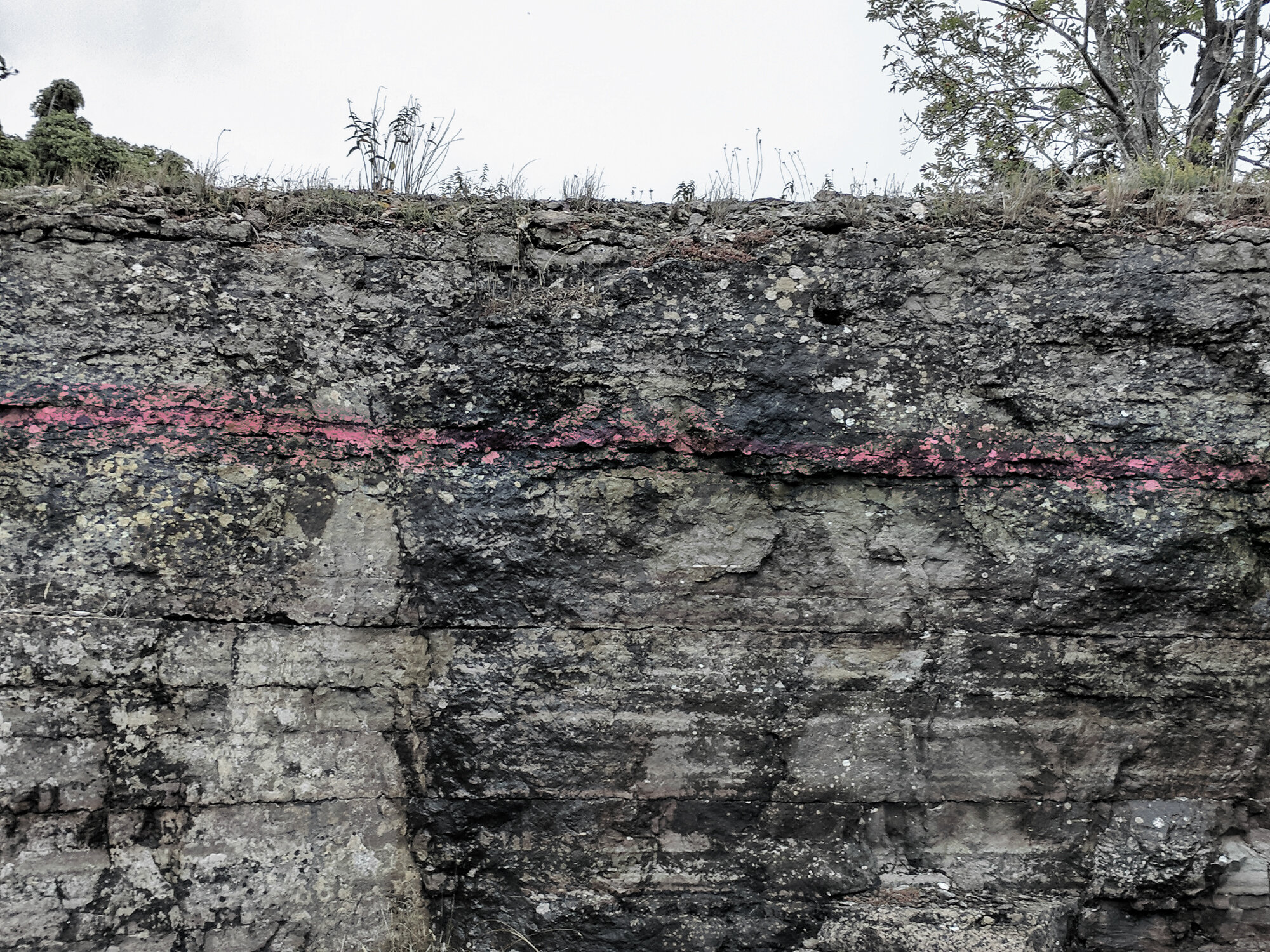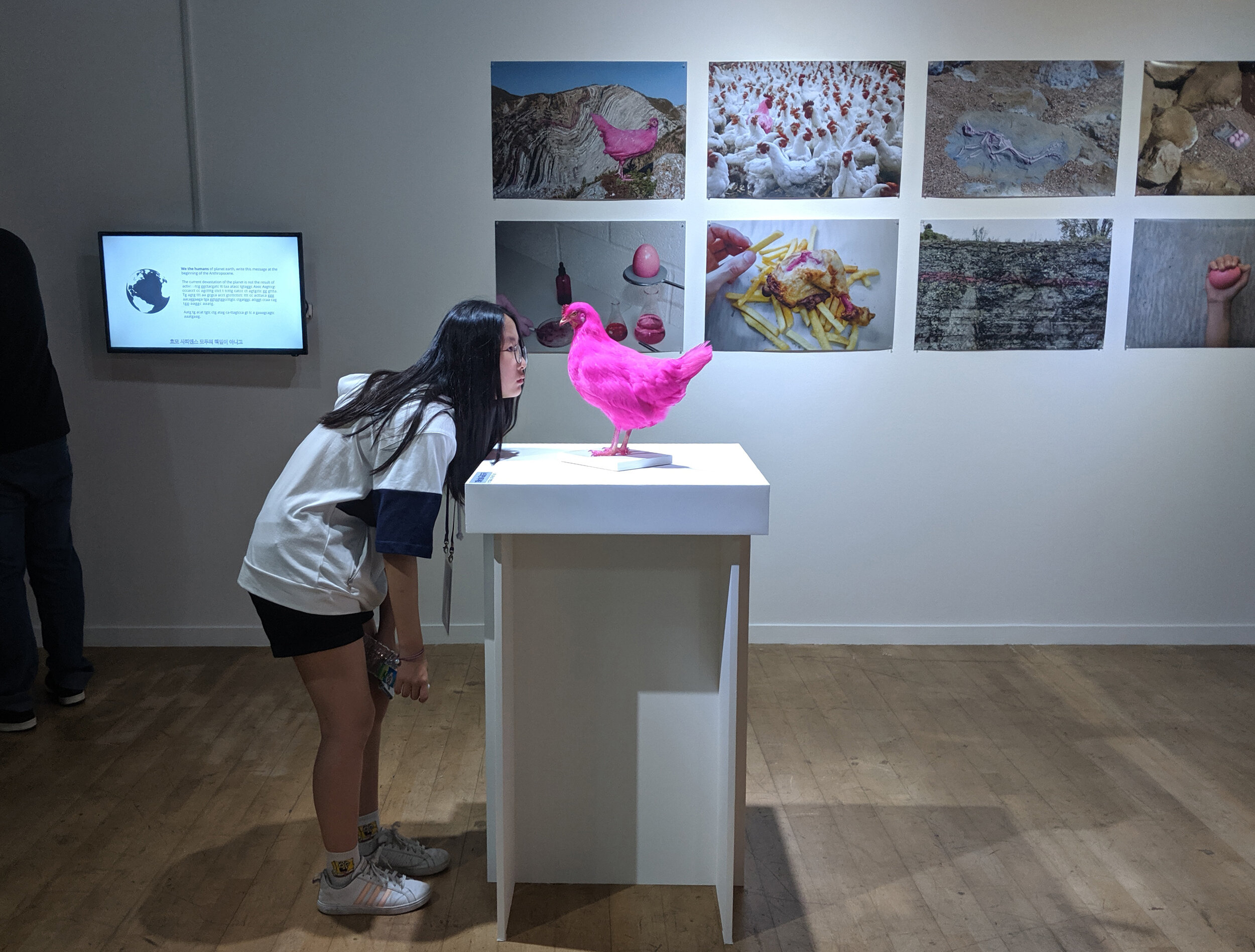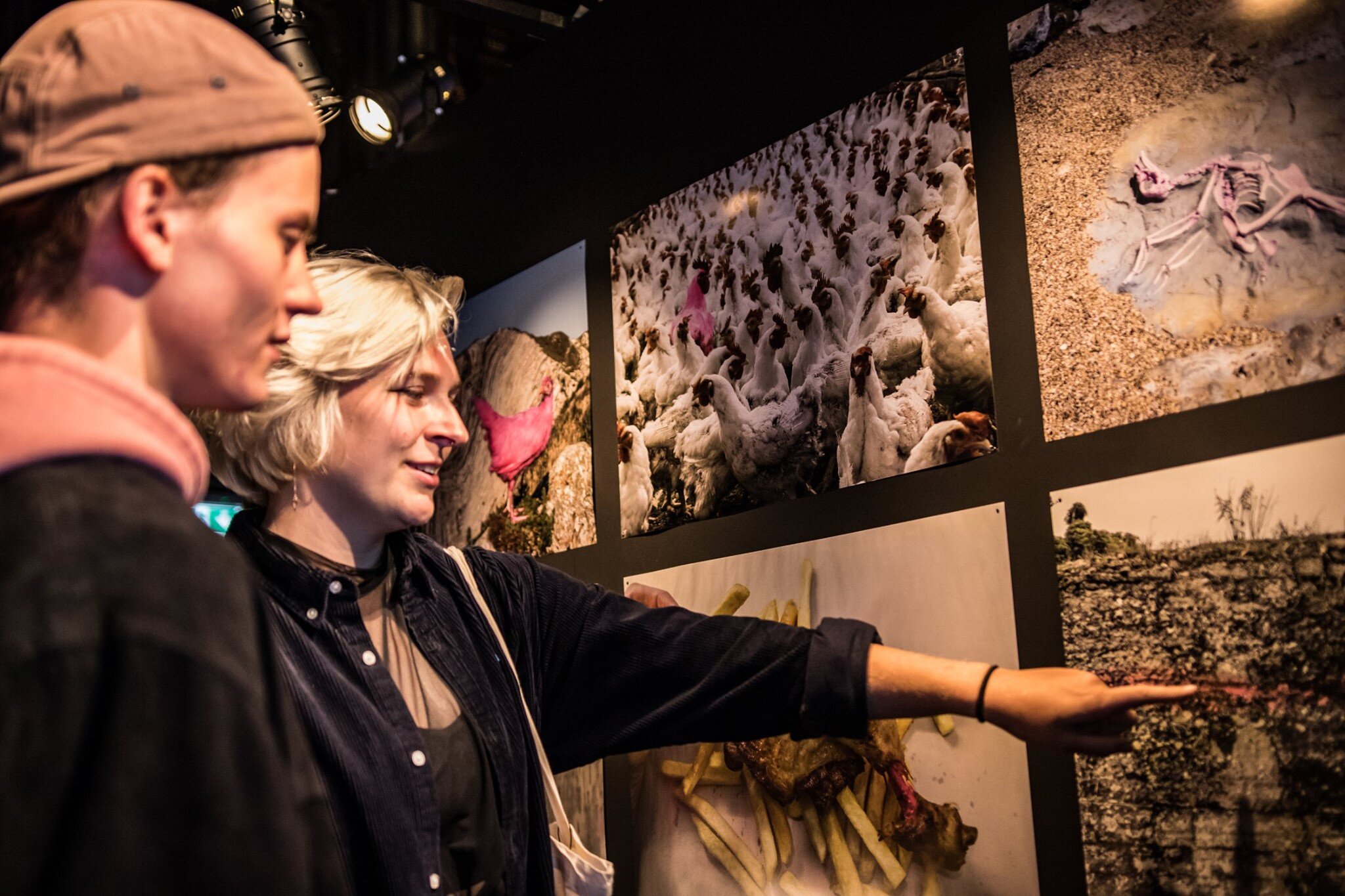PINK CHICKEN PROJECT
Coloring all chickens pink with a CRISPR Gene Drive
Re-occupying the Rock Strata











The Pink Chicken Project is a speculative bioengineering proposal that envisions using a groundbreaking biotechnology called Gene Drive to genetically modify the bones and feathers of all chickens worldwide, turning them pink. Geologists predict that chicken bones will serve as a key marker of the Anthropocene—the epoch defined by human impact on the planet. By altering the future fossil record, this intervention would imprint a pink line into the rock strata.
Beyond its visual impact, each chicken carries a manifesto encoded in its DNA—a genetic message that questions the power structures driving the Anthropocene’s destruction and highlights the connection between social and ecological justice.
Presented as an activist campaign, this speculative proposal challenges us to critically reflect on the ethical and political dimensions of emerging biotechnologies. How does genetically altering an entire species compare to the existing violence inflicted on billions of chickens in factory farms? In a world where human influence continually reshapes nature, how can we cultivate more ethical relationships with nonhuman species?
Between utopia and dystopia...
The Pink Chicken Project began with the launch of a website describing (roughly) how a Gene Drive could be used on the entire species Gallus gallus Domesticus.
Citing risks of ecological collapse and the ongoing destruction of the biosphere, the project claims to “Re-occupy the Rock Strata”, aiming to send a message to future generations on the inequitable liability of the Anthropocene disaster:
“The current devastation of the planet is not the result of activities undertaken by the whole species Homo Sapiens: instead it derives from a small group of humans in power, upheld by the injustice of white supremacy, colonialism, patriarchy, heterosexism and ableism. We urge you to fight this oppression: for it enables and aggravates the anthropocentric violence forced upon the non-human world.”
Seemingly paradoxical, the project rejects the current violence inflicted upon the non-human world, but is itself an act of violence through the non-consensual modification of the bodies of billions of chickens.
As the project receives press attention and is discussed on social media, hundreds of people have expressed their view on why they would/wouldn’t order a pink egg, describing how it made them feel informed, inspired, hopeful or distressed.
Scientifically realistic and relevant, but not a reality … yet.
Developed in collaboration with a leading synthetic biology lab to make the science realistic and relevant - the Pink Chicken Project could be real, but should it be?
When assessing the impact of new technology, legislators, experts and communities are in a bind - it is always too early or too late. Too early because the possible risks are just vague speculation, or too late because society is already heavily invested or dependent on the technologies.
The Pink Chicken Project uses a scientifically sound scenario to allow many people to consider the ethical implications of this particular future, before it is upon us. It is multi-layered and contradictory, which opens for complexity, nuance, and multiple perspectives.
The project has not genetically modified any chickens, and never says that it has either. It seeks a balance between being thought-provoking and believable - but not directly deceptive.
The Anthropocene - an epoch defined by … chickens?
As geologists work to formalize the stratigraphic signals of a reconfigured biosphere, chicken bones are (surprisingly) a suggested identifier of this new age.
Developed in dialogue with the Anthropocene Working Group, the Pink Chicken Project reveals the immense scale of this terraforming enterprise, by showing how the yearly raising and slaughtering of 60 000 000 000 chickens around the globe has deep time reverberations.
It discusses how the naming of the epoch as “Anthropocene” has been widely critiqued for implying that ecocidal logic is inherent to “human nature”, a reasoning that erases the power differentials of colonialism and social injustice that underpin and drive the extractivist mindset of capitalism.
Even though alternative framings might be preferable, the all-encompassing epochal view can be useful to see our ensnarement in multiple interlocking systems that are in crisis simultaneously. A pink “Gene-Drive” broiler finds itself entangled in a perfect storm of climatic, extinctional, and biogeochemical exhaustion.
United Nations Intervention
In November 2018, the Pink Chicken Project intervened at the United Nations Convention on Biological Diversity.
At the United Nations, 196 Governments, International Bodies and representatives of Businesses, Education, NGOs and Science, are currently trying to agree on international regulations on “Engineered Gene Drives” - if and how they should be legal. It is a controversial topic, as some voices are describing them as “Biology’s Nuclear Weapon” - a technology with geopolitical ramifications.
At the moment, the discourse on Gene Drives at the UN and the international media is centered around another possible use case of the technology: to combat mosquito-borne diseases such as Malaria, Zika, and Chikungunya. However, NGOs and conservationists are highlighting that when assessing the potential impact of novel technologies, we can not only look at the best possible use case.
Accredited by the University of the Arts London, the Pink Chicken Project went to the COP-14 meeting of the Convention on Biological Diversity in Sharm El-Sheikh in Egypt. Intervening in the assembly, the project held a statement describing the possible future of pink chickens, urging the parties to think more long term about the implications of their decisions.
“Zooming out to geological timescales; are we being good ancestors?”
The outcome of COP-14 was unclear and inconclusive, with a treaty that cautions on the risks of engineered gene-drives but contains few actual legal restrictions. The resulting text talks of the “free, prior and informed consent of potentially affected indigenous peoples and local communities”, but does not mention if these are human, or nonhuman.
What now?
Pink Chicken Project is currently traveling exhibitions worldwide.
As the debate and the project continues, Nonhuman Nonsense is working towards the creation of a book that will overview the different perspectives in the discourse, and gather the knowledge and wisdom created in response to the initial speculative intervention. Please feel free to contact us if you wish to share your view, feedback or story.
IN Exhibition















Previously
DINOSAURE DOMESTIQUE
Museum of Postnatural History
Curated by Gil Oliveira, Museum of Postnatural History
Neuchâtel, Switzerland, 16 Mar - 11 Aug 2024
THE ANIMAL FARM SIMULATOR
Hyundai Motorstudio
Curated by Evelyn Chen
Beijing, China, 28 Apr - 8 Oct 2023
GENE CULTURES
MIT Museum
Curated by William Meyers
Boston, USA, 2 Oct 2022 - 2024
ALIENATED
Exhibition space 38CC
Curated by Isabelle Bisseling
Delft, Netherlands, 14 Aug - 10 Jul 2021
INTERSPECIES FUTURES
Center for Book Arts
Curated by Oscar Salguero
New York City, USA, 16 Apr - 26 Jul 202
POST-SPECULATIVE DESIGN AND DECOLONIZATION OF THE FUTURE
Electromuseum
Curated by Алиса Смородина
Moscow, Russia, 5 Feb - 4 Apr 2021
YOUNG SWEDISH DESIGN 2020 TOUR
Röhsska museet, Göteborg, 3 Oct - 1 Nov
Utopia Galleria, Umeå, 1 - 11 Sep
Form/Design Center Malmö, 13 Jun - 16 Aug
IKEA Museum, Älmhult, 29 Apr - 4 Jun
ArkDes, Stockholm, 3 Feb- 22 Mar
with Svensk Form
Sweden, 2020
SUSTAIN ABLE VOICES
IKEA museum
IKEA x the Swedish Society of Crafts and Design
Sweden:
Älmhult, IKEA Museum, 5 Mar 2020-31 Jan 2021
Linköping, Linköping university 14-18 sep 2020 and Skylten 5-11 Oct 2020
Leksand, Wallénhallen, Leksands folkhögskola, Oct 2020
Norrköping, Hallarna, 21-26 Sept 2020
Östersund, DIÖS fastigheter, 16 – 26 Nov 2020
Härnösand, Västernorrlands Museum, Bengt Lindström-rummet, 3 Mar – 29 Aug 2021
Karlstad, Värmlands Museum, 17 May-29 Aug 2021
Örebro, Kulturkvarteret, 15 jan-27 feb 2022
international:
Washington DC, USA, House of Sweden, 5 Mar-28 Jun 2020
Bukarest, Rumania, Romania Design Week, 4-13 jun 2021
St Petersburg, Russia, MEGA, jun 2021
Copenhagen, Denmark, 3daysofdesign, 16-18 Aep 2021
Kinshasa, Kongo-Kinshasa, Kinshasa Design Week, Oct 2021
PRZEMIANY FESTIVAL | Appetite and Apathy
Copernicus Science Centre
curation Michał Grzymała & Patrycja Strzetelska
Warsaw, Poland 3-6 Oct. 2019
GOGBOT 2019 | BIO THE NEW DIGITAL
Festival for Art Music and Creative Technology
creative direction by Kees de Groot
Enschede, the Netherlands 5-8 sept. 2019
DA VINCI CREATIVE 2019 | Living Life
Seoul Art Space Geumcheon
art direction by Cheon Heahyun
Seoul, South Korea 2019
DEEP TRASH Eco Trash
Bethnal Green Working Men's Club
Hosted by CUNTemporary
London, UK 19 April 2019
ReShape: Mutating Systems, Bodies and Perspectives
MU Artspace
curated by William Myers and Angelique Spaninks
Eindhoven, the Netherlands 2018
United Nations: Convention on Biological Diversity
Conference of Parties (COP-14)
accredited by UAL
Sharm El-Sheikh, Egypt 2018
BioDesign: From Inspiration to Integration
Rhode Island School of Design
Edna Lawrence Nature Lab
curated by William Meyers
Providence, RI, USA 2018
United Nations: Convention on Biological Diversity
Subsidiary Body on Scientific, Technical and Technological Advice (SBSTTA-22)
accredited by UAL
Montréal, Canada 2018
CSM: Degree Show
MA Material Futures
Central Saint Martins
University of the Arts London
London, England 2018
Embassy of Food
Dutch Design Week
curated by Marije Vogelzang
Eindhoven, the Netherlands 2017
Press
VICE Motherboard: These People Want to Genetically Engineer Pink Chickens
Gizmodo Earther: The Fossils of the 21st Century
Next Nature Network: Pink GM Chicken Marks Anthropocene
Makery: Who wants to eat flourescent pink chicken?
Dezeen: Creative Ideas to change the food system
Discover Magazine: Scientists propose a new Marker for the Anthropocene: Chickens
Ahram Online: Swedish duo bring pink chicken to Egypt to raise debate about new gene editing tech








